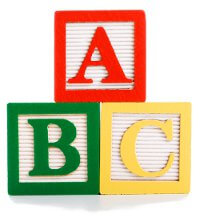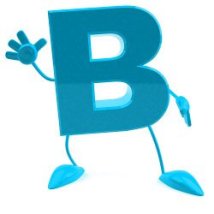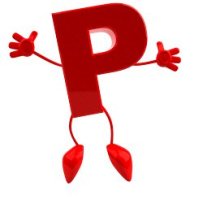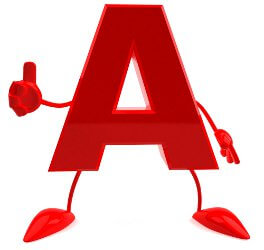How to Teach the Alphabet (ESL)
In this article we will
cover the important points in teaching the Alphabet to ESL
students (both young learners and adults).
Learning and teaching the ABCs in English can be a challenge. The alphabet used in an English learner's language may be completely different from the English alphabet!
There are many important things to keep in mind when first working with the ABCs, but don't worry! These guidelines can help you to avoid common teaching mistakes and help your students learn as easily as possible.
Read these tips for ideas on how to teach the alphabet in English as you work with the first letters and letter combinations with your ESL students.
Click Here for Step-by-Step Rules, Stories and Exercises to Practice All English Tenses
Learning and teaching the ABCs in English can be a challenge. The alphabet used in an English learner's language may be completely different from the English alphabet!
There are many important things to keep in mind when first working with the ABCs, but don't worry! These guidelines can help you to avoid common teaching mistakes and help your students learn as easily as possible.
Read these tips for ideas on how to teach the alphabet in English as you work with the first letters and letter combinations with your ESL students.

1. Begin at the beginning!

Learning a new alphabet is a big challenge, and it can feel like you're trying to move mountains at first! Since the English alphabet has the added difficulty of containing letters that are not always pronounced the same way, it's very important to begin with small groups of letters that are almost always pronounced the same way.
- Try starting with the consonants: B, D, N, P and the
vowel: E.
- Choose letters you can use to make simple, one-syllable
words for your students to practice.
For example: bed, pen, den.
You can see some examples in our story for beginners:
Introduction Story
You can explain to your students that there are two kinds of letters in the English alphabet: vowels and consonants. Tell them that you will learn more of each kind as you continue with your lessons.
It's better to use real words, not nonsense combinations. Your students won't remember all the vocabulary they learn right in the beginning, but these words can stick in their memory!
Remember that at first it's a good idea to avoid vowel combinations and letters that are pronounced several different ways (like C as in "car" or "city"), as well as letters that are often used in combinations (like Q, which is not commonly used except with the letter U) or very uncommon letters (like X or Z).
2. Practice makes perfect

Now that your students have some basic sounds, it's important to get in lots of practice before moving on.
It's important to associate the letter's form with its sound, so your games and activities should have this in mind! Try some of the following ideas:
- Read a letter's name ("bee" for B) and have a
student at the board write the upper case form. Extra points for the
lower case form, too!
- Use flashcards with letters and your simple practice words
on them. Hold them up and have the students say the word or letter.
- Create
a song or chant with your letters and words. You can keep making it
longer as you learn more letters, which will be a fun challenge for
your students. Play with the rhymes that will be created using your
vowel sounds.
- Have the students quiz each other by saying a letter and having their partner write the upper and lower case forms. Or, they can write the letter first, and their partner should say the letter name and a word that contains it.
Also be sure to work just with the print alphabet (not the cursive alphabet) to begin with.
3. Take it in phases

Again, we are thinking about the simple, one-syllable words we'll be able to make. These are also letters that are usually pronounced the same way when they are not in combinations.
Examples: hot, hop, mom, pop, top, pot, bet, men, hen, hem, pen
- Keep working with groups of four or five consonants and a
vowel until you complete the alphabet.
- Be sure to do lots
of practice with games and different activities
on each set before moving on! As you learn more letters, you will be
able to create more interesting activities and sing the alphabet song.
In fact, it's a great idea to start working with simple stories using your letters.
For example:
Bob met
Ken.
Tom met Bob and Ken.
Ken and Bob sit.
Tom and Bob jump.
Tom met Bob and Ken.
Ken and Bob sit.
Tom and Bob jump.
Visit our English Short Stories section for many simple stories such as these.
Notice that we have simple consonant combinations here in which the letter sounds do not change. It's still a good idea to avoid more complex combinations like "gh", "ch", "qu", "ea", "oo", and silent letters. You should work on these last, once the students are comfortable with the basic letter sounds.
4. Work with names

As you noticed in the point above, names can be a good way to practice these letters. For example, we introduced the letter K, but we had a hard time finding simple words we could use it in. Still, this letter is important and is almost always pronounced the same way. It's also very common in names!
Students love to work with ideas and topics that are real for them in their own lives. You can use names in two different ways:
- Help the students write
their own names
using the English alphabet. Try to find the best equivalents for the
sounds you need and the simplest combinations. Have the students try on
their own and help the group.
- Some teachers also enjoy letting their students choose "English names" that they can use in class. This is a common practice in language classes that might be fun for you to try as an activity. This is wonderful to pair with your first introduction vocabulary. The students can take turns introducing themselves with their real name and their "English class name" for practice.
This is a good way for them to practice the sounds without having to learn too many new words. As we saw above, the combinations will let you make more and more words, so be sure to take it slow. A common mistake is to give too much vocabulary too quickly.
5. Teach to your age group

Remember that children and adult ESL learners have different needs and styles. Lessons should always be fun and interactive, but of course your games will be different for different levels.
Try these tips with children:
- Use lots of pictures and flashcards
to associate the sounds
and letter names with the letter itself.
- Try using blocks for very young children. They can touch
these and pass them around as they learn.
- Songs and chants work very well with children. They help
them to memorize words and sounds in an interactive way with their
classmates.
- You can also use lots of repeating exercises to help kids
practice pronouncing the sounds and the letter names.
Keep these points in mind with adults:
- Visual aids are also important! Be sure to associate the
upper and lower case letter figures with the letter names and sounds.
- Help
the students learn to spell their names out loud. This is a skill they
will need to use in English for class registrations, hotel
reservations, etc.
- Put the games and activities
in "real terms" by mentioning these practical uses for the simple
skills your adult students are learning.
- Use pair, group, or team activities when possible. Adult learners enjoy working collaboratively as a team and competing against one another or the other team.

Keep these tips in mind, and teaching the alphabet will be a
breeze for
you and your students!
Download your FREE GIFT (the first two chapters of

Get Updates, Special Offers, and English Resources
Download your FREE GIFT (the first two chapters of
English Short Stories Book and Workbook)
as soon as you join!

By submitting your email, you consent to receiving updates and newsletters from us and to the sharing of your personal data with third parties for the purposes of sending you communications. We will not spam you. You can unsubscribe at any time. For more information, please see our privacy policy.
Return
from How to Teach the Alphabet (ESL) to How to Teach English
Return to
Really Learn
English Home Page





